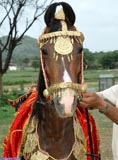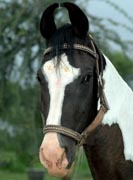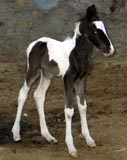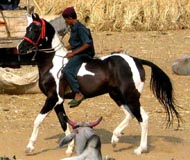The Marwari horses were brought to India by Central-Asian and Muslim invaders. Their home was the desert kingdom of Marwar and from there, the breed spread through the whole of Rajasthan. The name 'Marwari' means quite literally ‚Äúfrom the land of death‚ÄĚ.
Over the centuries, the Marwari horse was bred in the harsh desert climate of Rajasthan by warring Rajput clans. The outcome was a hardy, intelligent horse with a great stamina, which could thrive on little food and water. Trained highly in the art of war it was known for its bravery on the battlefield.
Fighting against elephants the Marwari horse had to stand up on its hind legs and provide the rider with an opportunity to kill the combatant sitting on top of the elephant in its howdah. On the battlefield, horse and warrior had to become one in order to fight and survive, so the Marwari Horse is said to have an extraordinary instinct and the ability to act upon the mere thoughts of the rider. Besides this, the Marwari is fiercely loyal and is known for always being able to bring its rider home.
The Marwari courage and gallantry are the theme of many songs and tales. The most famous example is the story of how the Marwari steed Chetak saved his master Maharana Pratap in the battle of Haldi Ghati in 1546. The Maharana was fighting against the army of Akbar the Great and had to flee after the battle was lost. Though mortally wounded, with one foot severed, Chetak carried his master to safety by jumping over a river. Only then he gave up his life and died, according to the legend, in his master’s arms. Maharana Pratap never forgot his loyal Chetak and when the circumstances improved, he erected a monument in his memory. This memorial still exists today in the village of Haldi Ghati, 30 km north of Udaipur.
The Rajput did not yearn for wealth or riches. Instead in his prayers to his goddess, he never failed to remind her that all which mattered to him, was being able to face the challenges of life with a sword in his hand and a horse by his side. One day of the year was specially dedicated to honor and worship his horse in recognition of his unfailing contribution to the survival of the Rajput race. This tradition has survived till today and is observed for the occasion of Durga Ashtami in October each year.
The fortunes of the Marwari horses changed with the ascendancy of the British in India. British officers found the Marwari too undersized and hot tempered, so they imported shiploads of Australian Whalers. They were quick, tough and inexpensive. Over time, instead of keeping Marwari horses, the Maharajas bought expensive thoroughbreds or Australian mounts. Having surrendered their very raison d’etre, India’s former kings and nobles lost a fundamental part of their soul and left their heritage and traditions behind. After independence things did not improve for the Marwari horse, in fact the situation worsened. Being perceived as a symbol for the despised feudalism, many Marwari horses were castrated, killed and scattered. The breed was neglected for decades and few pure specimen survived.
Finally the Marwari horse was saved by its own people. Local landed gentry managed to rescue a few animals and started their own breeding programs.
The Future for the Marwari Horses and their role in Horse Tourism for India: Tourism and horseback-safaris have provided a tremendous boost to the revival of the Rajput culture and ultimately to the future of the Marwari horse. Today there are countless breeders in Rajasthan, Gujerat as well as the Punjab and the prospect of the Marwari horse looks brighter than it has for a long time.
Characteristics of the Marwari Horse Breed: The Marwari horse is a medium-sized, elegant horse.
The most distinguishing features of the Marwari horse are its lyre-shaped ears, which curve inward and often meet at the tips. Besides providing a sharp hearing, they can turn 180 degrees.It has a longish head with a broad forehead, wide-set and alert eyes and a well-shaped, rather small mouth. It is elegantly proportioned with a proud head carried on a well-arched neck. The legs are straight and sound with small and very hard hooves. The coat of the Marwari horse is silky and often has the metallic shine of the Turkmeni horses. It comes in all colours, including piebald and skewbald. Very popular as well, are the Cremellos, which in Rajasthan are called Nukra.

Many Marwari horses are gifted with a 4th gait, the so-called Revaal, a kind of amble, which is very comfortable for the rider to sit. In the Revaal, the Marwari horse can cover large distances very smoothly and speedily. It is however not found in all individuals and does not impact the breed standard.
Photography supplied with kind permission of Princess Trails.
|





|
